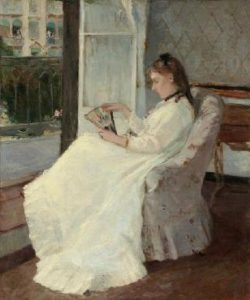 A woman like Berthe Morisot, a member of the 19thcentury Parisian upper-class, could study painting to add to her list of accomplishments, but aspiring for professional status was out of the question. Hiring professional models was similarly uacceptable. As a result, Berthe Morisot relied on the women in her life to model for her. Her sister, Edma, was a frequent model. (You can see her in well-known Morisot paintings, including The Cradle, Hide and Seek, and Chasing Butterflies.) The Artist’s Sister at a Window (1869) features the signature characteristics of Berthe’s paintings.
A woman like Berthe Morisot, a member of the 19thcentury Parisian upper-class, could study painting to add to her list of accomplishments, but aspiring for professional status was out of the question. Hiring professional models was similarly uacceptable. As a result, Berthe Morisot relied on the women in her life to model for her. Her sister, Edma, was a frequent model. (You can see her in well-known Morisot paintings, including The Cradle, Hide and Seek, and Chasing Butterflies.) The Artist’s Sister at a Window (1869) features the signature characteristics of Berthe’s paintings.
She often painted women lost in thought, and once you learn that her sister Edma was expecting a child when she sat for this painting, it’s easy to imagine the focus of her reverie. Berthe has shown Edma seated in an armchair with her foot resting on the ledge of an open window, but oblivious to anything outside. She looks at a Japanese fan, but does she see it? Berthe’s use of muted colors reinforces the pensive mood of the painting.
Something else might also have been on Edma’s mind when Berthe painted her during the autumn of 1869, a year after she had married and left Paris. It was the first time that the two sisters had been separated, and Berthe went for a visit as soon as Edma was settled. Although Edma had trained to be an artist—some thought a more talented artist than Berthe—she had succumbed to societal pressure to marry, which effectively ended her artistic career. Without the stimulation of other artists, and with domestic duties, and soon a child, to occupy her, Edma felt only “annoyed and tired” when she tried to paint.
Edma’s fan is a reference to then-current Parisian fad of Japonism, and the painting itself exhibits its influence. Like the Japanese Ukiyo-e woodblock prints that were the rage, The Artist’s Sister at a Window shows a single figure, an ordinary person (no queen or Greek goddess), against a plain background, engaged in an everyday activity.
All of the Impressionists were interested in depicting modernity—the new broad boulevards and sandstone apartment buildings, as well as the café concerts and other entertainments where, for the first time, workers and the haute-bourgeois mingled. But as an upper-class woman, Berthe was unable to join them, or even to meet her colleagues at a café for talk about art. So for the most part, she showed women in contained spaces, not fully participating in the modern world. Through the French doors behind Edma, one can make out male figures standing under green awnings on a balcony outside the modern apartment building across the street, observing the passers-by below. Perhaps they will join them in strolling the boulevards, while Edma remains inside.
Although this is an indoor scene, outdoor light pours in through those French doors. Berthe’s love of light is evident in the way she shows it reflecting off of the white door, edges the front of the armchair, and illuminates Edma’s peignoir.
Reverie, modernity, Japonism, and light—these are as much a part of Berthe Morisot’s artistic palette as are her paints.
